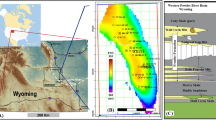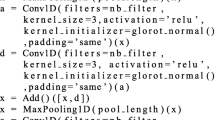Abstract
Many hydrological, environmental, or engineering exploration tasks require predicting spatially continuous scenarios of sparsely measured borehole logging data. We present a methodology to probabilistically predict such scenarios constrained by ill-posed geophysical tomography. Our approach allows for transducing tomographic reconstruction ambiguity into the probabilistic prediction of spatially continuous target parameter scenarios. It is even applicable to data sets where petrophysical relations in the survey area are non-unique, i.e., different facies related petrophysical relations may be present. We employ static two-layer artificial neural networks (ANNs) for prediction and additionally evaluate, whether the training performance of the ANNs can be used to rank geophysical tomograms, which are mathematically equal reconstructions of physical parameter distributions in the ground. We illustrate our methodology using a realistic synthetic database for maximal control about the prediction performance and ranking potential of the approach. For doing so, we try to link geophysical radar and seismic tomography as input parameters to porosity of the ground as target parameter of ANN. However, the approach is flexible and can cope with any combination of geophysical tomograms and hydrologic, environmental or engineering target parameters. Ranking of equivalent geophysical tomograms based on additional borehole logging data is found to be generally possible, but risks remain that the ranking based on the ANN training performance does not fully coincide with the closeness of geophysical tomograms to ground truth. Since geophysical field data sets do usually not offer control options similar to those used in our synthetic database, we do not recommend the utilization of recurrent ANNs to learn weights for the individual geophysical tomograms used in the prediction procedure.












Similar content being viewed by others
References
Angioni T, Rechtien RD, Cardimona SJ, Luna R (2003) Crosshole seismic tomography and borehole logging for engineering site characterization in Sikeston. Tectonophysics 368:119–137
Archie GE (1942) The electrical resistivity log as an aid in determining some reservoir characteristics. Trans Am Inst Mineral Met 146:54–62
Asadi A, Dietrich P, Paasche H (2016) 2D probabilistic prediction of sparsely measured geotechnical parameters constrained by tomographic ambiguity and measurement errors. In: Expanded abstracts of the 78th EAGE conference and exhibition, Vienna. doi:10.3997/2214-4609.201601402
Aster RC, Borchers B, Thurber CH (2005) Parameter Estimation and Inverse problems. Academic Press, Cambridge
Bailly K, Milgram M (2009) Boosting feature selection for neural network based regression. Neural Netw 22:748–756
Balling R (2003) The maximin fitness function; multi-objective city and regional planning. In: Fonseca CM, Fleming PJ, Zitzler E, Deb K, Thiele L (eds) Second international conference on evolutionary multi-criterion optimization, Springer Lecture Notes in Computer Science, vol 2632, pp 1–15
Ban JC, Chang CH (2013) The learning problem of multi-layer neural networks. Neural Netw 46:116–123
Binley A, Winship P, Middelton R (2001) High-resolution characterization of vadose zone dynamics using cross-borehole radar. Water Resour Res 37:2639–2652
Bodin T, Sambridge M (2009) Seismic tomography with the reversible jump algorithm. Geophys J Int 178:1411–1436
Bodin T, Sambridge M, Rawlinson N, Arroucau P (2012) Transdimensional tomography with unknown data noise. Geophys J Int 189:1536–1556
Boisclair CD, Gloaguen E, Marcotte D, Giroux B (2011) Heterogeneous aquifer characterization from ground-penetrating radar tomography and borehole hydrogeophysical data using nonlinear Bayesian simulations. Geophysics 76:J13–J25
Bosch M, Mukerji T, Gonzalez FE (2010) Seismic inversion for reservoir properties combining statistical rock physics and geostatistics: a review. Geophysics 75:165–176
Breiman L, Friedman JH (1985) Estimating optimal transformations for multiple regression and correlation. J Am Stat Assoc 80:580–598
Cassiani G, Böhm G, Vesnaver A, Nicolich R (1998) A geostatistical framework for incorporating seismic tomography auxiliary data into hydraulic conductivity. J Hydrol 206:58–74
Cawley GC, Janacek GJ, Haylock MR, Dorling SR (2007) Predictive uncertainty in environmental modelling. Neural Netw 20:537–549
Chen J, Hubbard S, Rubin Y (2001) Estimating the hydraulic conductivity at the South Oyster Site from geophysical tomographic data using Bayesian techniques based on the normal linear regression. Water Resour Res 37:1603–1613
Dafflon B, Irving J, Holliger K (2009) Simulated-annealing-based conditional simulation for the local-scale characterization of heterogeneous aquifers. J Appl Geophys 68:60–70
Duan S, Hu X, Dong Z, Wang L, Mazumder P (2015) Memristor-based cellular nonlinear/neural network: design, analysis, and applications. IEEE Trans Neural Netw Learn Syst 26:1202–1213
Ezzedine S, Rubin Y, Chen J (1999) Bayesian method for hydrogeological site characterization using borehole and geophysical survey data: theory and application to the Lawrence Livermore National. Water Resour Res 35:2671–2683
Frénay B, Doquire G, Verleysen M (2013) Is mutual information adequate for feature selection in regression? Neural Netw 48:1–7
Friedel S (2003) Resolution, stability and efficiency of resistivity tomography estimated from a generalized invers approach. Geophys J Int 153:305–316
Ganivada A, Sankar Ray S, Pal SK (2013) Fuzzy rough sets, and a granular neural network for unsupervised feature selection. Neural Netw 48:91–108
Gassmann F (1951) Über die Elastizität poröser Medien. Vierteljahresschrift der Naturforsch. Ges., Zürich, vol 96, pp 1–22
Gloaguen E, Chaouteau M, Marcotte D, Chaouis R (2001) Estimation of hydraulic conductivity of an unconfined aquifer using cokriging of GPR and Hydrostratigraphic data. J Appl Geophys 47:135–152
Hornik K (1991) Approximation capabilities of multilayer feedforward networks. Neural Netw 4:251–257
Hubbard S, Chen J, Peterson J, Majer E, Williams K, Swift D, Mailliox B, Rubin Y (2001) Hydrogeological characterization of the D.O.E. bacterial transport site in Oyster Virginia using geophysical data. Water Resour Res 37:2431–2456
Jain AK, Mao J, Mohiuddin KM (1996) Artificial neural networks: a tutorial. IEEE Comput 29:31–44
Jing X (2012) Robust adaptive learning of feedforward neural networks via LMI optimizations. Neural Netw 31:33–45
Kennedy J, Eberhart RC (1995) Particle swarm optimization. In: Proceedings of IEEE international conference on neural networks, Piscataway, 1942–1948
Khoshdel H, Riahi MA (2011) Multi attribute transform and neural network in porosity estimation of an offshore oil field—a case study. J Petrol Sci Eng 78:740–747
Kiranyaz S, Ince T, Yildirim AG (2009) Evolutionary artificial neural networks by multi-dimensional particle swarm optimization. Neural Netw 22:1448–1462
Knödel K, Krummel H, Lange G (1997) Handbuch zur Erkundung des Untergrundes von Deponien und Altlasten. Springer, Berlin
Leite EP, de Souza Filho CR (2009) Artificial neural networks applied to mineral potential mapping for copper-gold mineralizations in the Carajás Mineral Province, Brazil. Geophys Prospect 57:1049–1065
Leite EP, Vidal AC (2011) 3D porosity prediction from seismic inversion and neural networks. Comput Geosci 37:1174–1180
Leray P, Gallinari P (2002) Feature selection with neural networks. Behaviormetrika 26:145–166
Liu H, Motoda H (1998) Feature transformation and subset selection. IEEE Intell Syst 13:26–28
Liu H, Motoda H (2001) Feature extraction, construction and selection: a data mining perspective. Kluwer Academic Publishers, Boston
Miche Y, Sorjamaa A, Bas P, Simula O, Jutten C, Lendasse A (2010) OP-ELM: optimally pruned extreme learning machine. IEEE Trans Neural Netw 21:158–162
Mitchell M (1998) An introduction to genetic algorithms. MIT Press, Cambridge
Paasche H (2015) Fully non-linear self-organizing inversion of cross-borehole tomographic data. In: Near Surface Geoscience—21st European meeting of environmental and engineering geophysics, Italy
Paasche H (2017a) Translating tomographic ambiguity into the probabilistic inference of hydrologic and engineering target parameters. Geophysics (submitted)
Paasche H (2017b) Probabilistic inference of spatially continuous geotechnical parameter fields by means of sparse calibration data and geophysical tomography. Geophys Prospect (submitted)
Paasche H, Tronicke J (2007) Cooperative inversion of 2D geophysical data set: a zonal approach based on fuzzy c-means cluster analysis. Geophysics 72:35–39
Paasche H, Tronicke J, Holliger K, Green AG, Maurer HR (2006) Integration of diverse physical-property models: subsurface zonation and petrophysical parameter estimation based on fuzzy c-means cluster analyses. Geophysics 71:H33–H44
Pham DL (2001) Spatial models for fuzzy clustering. Comput Vis Image Underst 84:285–297
Poulton MM (2002) Neural networks as an intelligence amplification tool: a review of applications. Geophysics 67:979–993
Quan H, Srinivasan D, Khosravi A (2014) Short-term load and wind power forecasting using neural network-based prediction intervals. IEEE Trans Neural Netw Learn Syst 25:303–315
Raeesi M, Moradzadeh A, Doulati Ardejani F, Rahimi M (2012) Classification and identification of hydrocarbon reservoir lithofacies and their heterogeneity using seismic attributes, logs data and artificial neural networks. J Petrol Sci Eng 82:151–165
Raymer DS, Hunt ER, Gardner JS (1980) An improved sonic transit time-to-porosity transform. In: Proceeding of SPWLA 21st ann. Meeting, paper P
Razavi S, Tolson BA (2011) A new formulation for feedforward neural networks. IEEE Trans Neural Netw 22:1588–1598
Roy L, Sen MK, McIntosh K, Stoffa PL, Nakamura Y (2005) Joint inversion of first arrival seismic travel-time and gravity data. J Geophys Eng 2:277–289
Ruggeri P, Irving J, Gloaguen E, Holliger K (2013) Regional scale integration of multiresolution hydrological and geophysical data using a two-step Bayesian sequential simulation approach. Geophys J Int 194:289–303
Rumpf M, Tronicke J (2014) Predicting 2D geotechnical parameter fields in near-surface sedimentary environments. J Appl Geophys 101:95–107
Schön JH (1998) Physical properties of rocks: fundamentals and principles of petrophysics. Pergamon Press, Oxford
Schwarzbach C, Börner RU, Spitzer K (2005) Two-dimensional inversion of direct current resistivity data using a parallel, multi-objective genetic algorithm. Geophys J Int 162:685–695
Seteiono R, Liu H (1997) Neural-network feature selector. IEEE Trans Neural Netw 8:354–362
Topp GC, Davis JL, Annan AP (1980) Electromagnetic determination of soil water content: measurements in coaxial transmission lines. Water Resour Res 16:574–582
Tronicke J, Holliger K (2005) Quantitative integration of hydrogeophysical data: conditional geostatistical simulation for characterizing heterogeneous alluvial aquifers. Geophysics 70:H1–H10
Tronicke J, Paasche H, Böniger U (2012) Crosshole traveltime tomography using particle swarm optimization: a near-surface field example. Geophysics 77:R19–R32
Van der Baan M, Jutten C (2000) Neural networks in geophysical applications. Geophysics 65:1032–1047
Velis DR (2001) Traveltime inversion for 2D anomaly structures. Geophysics 66:1481–1487
Verikas A, Bacauskiene M (2002) Feature selection with neural networks. Pattern Recognit Lett 23:1323–1335
Wharton RP, Hazen GA, Rau RN, Best DL (1980) Advancements in electromagnetic propagation logging. In: SPE 9267 American institute of mining metallurgical and petroleum engineers
Widrow B, Greenblatt A, Kim Y, Park D (2013) The No-Prop algorithm: a new learning algorithm for multilayer neural networks. Neural Netw 37:182–188
Wu X, Rozycki P, Wilamowski BM (2015) A hybrid constructive algorithm for single-layer feedforward networks learning. IEEE Trans Neural Netw Learn Syst 26:1659–1668
Wyllie MRJ, Gregory AR, Grander LW (1956) Elastic wave velocities in heterogeneous and porous media. Geophysics 26:41–70
Yamamoto T (2001) Imaging the permeability structure within the near-surface sediments by acoustic crosswell tomography. J Appl Geophys 47:1–11
Yan H, Yang J (2015) Locality preserving score for joint feature weights learning. Neural Netw 69:126–134
Author information
Authors and Affiliations
Corresponding author
Rights and permissions
About this article
Cite this article
Asadi, A., Dietrich, P. & Paasche, H. 2D probabilistic prediction of sparsely measured earth properties constrained by geophysical imaging fully accounting for tomographic reconstruction ambiguity. Environ Earth Sci 75, 1487 (2016). https://doi.org/10.1007/s12665-016-6288-8
Received:
Accepted:
Published:
DOI: https://doi.org/10.1007/s12665-016-6288-8




